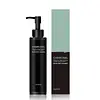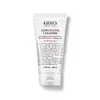What's inside
What's inside
 Key Ingredients
Key Ingredients

 Benefits
Benefits

 Concerns
Concerns

 Ingredients Side-by-side
Ingredients Side-by-side

Water
Skin ConditioningLauramidopropyl Betaine
CleansingGlycerin
HumectantSodium Cocoamphoacetate
CleansingLauric Acid
CleansingAcrylates Copolymer
1,2-Hexanediol
Skin ConditioningDipropylene Glycol
HumectantButylene Glycol
HumectantPotassium Hydroxide
BufferingDisodium EDTA
Caprylyl Glycol
EmollientQuercus Serrata Extract
Skin ConditioningAngelica Gigas Root Extract
Skin ConditioningCucumis Sativus Fruit Extract
EmollientGlycyrrhiza Uralensis Root Extract
Skin ConditioningJuniperus Communis Fruit Extract
PerfumingGinkgo Biloba Leaf Extract
Skin ConditioningPanax Ginseng Root Extract
EmollientCitrus Unshiu Peel Extract
MaskingNelumbo Nucifera Root Extract
Skin ConditioningEthylhexylglycerin
Skin ConditioningParfum
MaskingSucrose
HumectantCharcoal Powder
AbrasiveHydrolyzed Corn Starch
HumectantHelianthus Annuus Seed Oil
EmollientBertholletia Excelsa Seed Oil
EmollientArgania Spinosa Kernel Oil
EmollientSimmondsia Chinensis Seed Oil
EmollientOrbignya Oleifera Seed Oil
EmollientTropolone
Skin ConditioningWater, Lauramidopropyl Betaine, Glycerin, Sodium Cocoamphoacetate, Lauric Acid, Acrylates Copolymer, 1,2-Hexanediol, Dipropylene Glycol, Butylene Glycol, Potassium Hydroxide, Disodium EDTA, Caprylyl Glycol, Quercus Serrata Extract, Angelica Gigas Root Extract, Cucumis Sativus Fruit Extract, Glycyrrhiza Uralensis Root Extract, Juniperus Communis Fruit Extract, Ginkgo Biloba Leaf Extract, Panax Ginseng Root Extract, Citrus Unshiu Peel Extract, Nelumbo Nucifera Root Extract, Ethylhexylglycerin, Parfum, Sucrose, Charcoal Powder, Hydrolyzed Corn Starch, Helianthus Annuus Seed Oil, Bertholletia Excelsa Seed Oil, Argania Spinosa Kernel Oil, Simmondsia Chinensis Seed Oil, Orbignya Oleifera Seed Oil, Tropolone
Water
Skin ConditioningSodium Laureth Sulfate
CleansingDecyl Glucoside
CleansingGlycerin
HumectantCocamidopropyl Betaine
CleansingDisodium Cocoamphodiacetate
CleansingAcrylates Copolymer
Lauryl Glucoside
CleansingPEG-200 Hydrogenated Glyceryl Palmate
CleansingTriethanolamine
BufferingSodium Chloride
MaskingPentylene Glycol
Skin ConditioningPhenoxyethanol
PreservativePEG-7 Glyceryl Cocoate
EmulsifyingSodium Hydroxide
BufferingCitric Acid
BufferingHexylene Glycol
EmulsifyingBehenyl Alcohol
EmollientDistearyl Ether
Skin ConditioningSodium Benzoate
MaskingLaureth-2
CleansingSqualane
EmollientPrunus Amygdalus Dulcis Oil
Skin ConditioningPrunus Armeniaca Kernel Oil
MaskingTocopherol
AntioxidantAscorbyl Glucoside
AntioxidantPersea Gratissima Oil
Skin ConditioningWater, Sodium Laureth Sulfate, Decyl Glucoside, Glycerin, Cocamidopropyl Betaine, Disodium Cocoamphodiacetate, Acrylates Copolymer, Lauryl Glucoside, PEG-200 Hydrogenated Glyceryl Palmate, Triethanolamine, Sodium Chloride, Pentylene Glycol, Phenoxyethanol, PEG-7 Glyceryl Cocoate, Sodium Hydroxide, Citric Acid, Hexylene Glycol, Behenyl Alcohol, Distearyl Ether, Sodium Benzoate, Laureth-2, Squalane, Prunus Amygdalus Dulcis Oil, Prunus Armeniaca Kernel Oil, Tocopherol, Ascorbyl Glucoside, Persea Gratissima Oil
 Reviews
Reviews

Ingredients Explained
These ingredients are found in both products.
Ingredients higher up in an ingredient list are typically present in a larger amount.
Acrylates Copolymer is used as a film-forming agent and texture enhancer.
After applied, Acrylates Copolymer forms a thin film cover that helps skin feel more soft. It can help sunscreens become more water-resistant.
It is also used to make a product more thick.
Learn more about Acrylates CopolymerGlycerin is already naturally found in your skin. It helps moisturize and protect your skin.
A study from 2016 found glycerin to be more effective as a humectant than AHAs and hyaluronic acid.
As a humectant, it helps the skin stay hydrated by pulling moisture to your skin. The low molecular weight of glycerin allows it to pull moisture into the deeper layers of your skin.
Hydrated skin improves your skin barrier; Your skin barrier helps protect against irritants and bacteria.
Glycerin has also been found to have antimicrobial and antiviral properties. Due to these properties, glycerin is often used in wound and burn treatments.
In cosmetics, glycerin is usually derived from plants such as soybean or palm. However, it can also be sourced from animals, such as tallow or animal fat.
This ingredient is organic, colorless, odorless, and non-toxic.
Glycerin is the name for this ingredient in American English. British English uses Glycerol/Glycerine.
Learn more about GlycerinWater. It's the most common cosmetic ingredient of all. You'll usually see it at the top of ingredient lists, meaning that it makes up the largest part of the product.
So why is it so popular? Water most often acts as a solvent - this means that it helps dissolve other ingredients into the formulation.
You'll also recognize water as that liquid we all need to stay alive. If you see this, drink a glass of water. Stay hydrated!
Learn more about Water